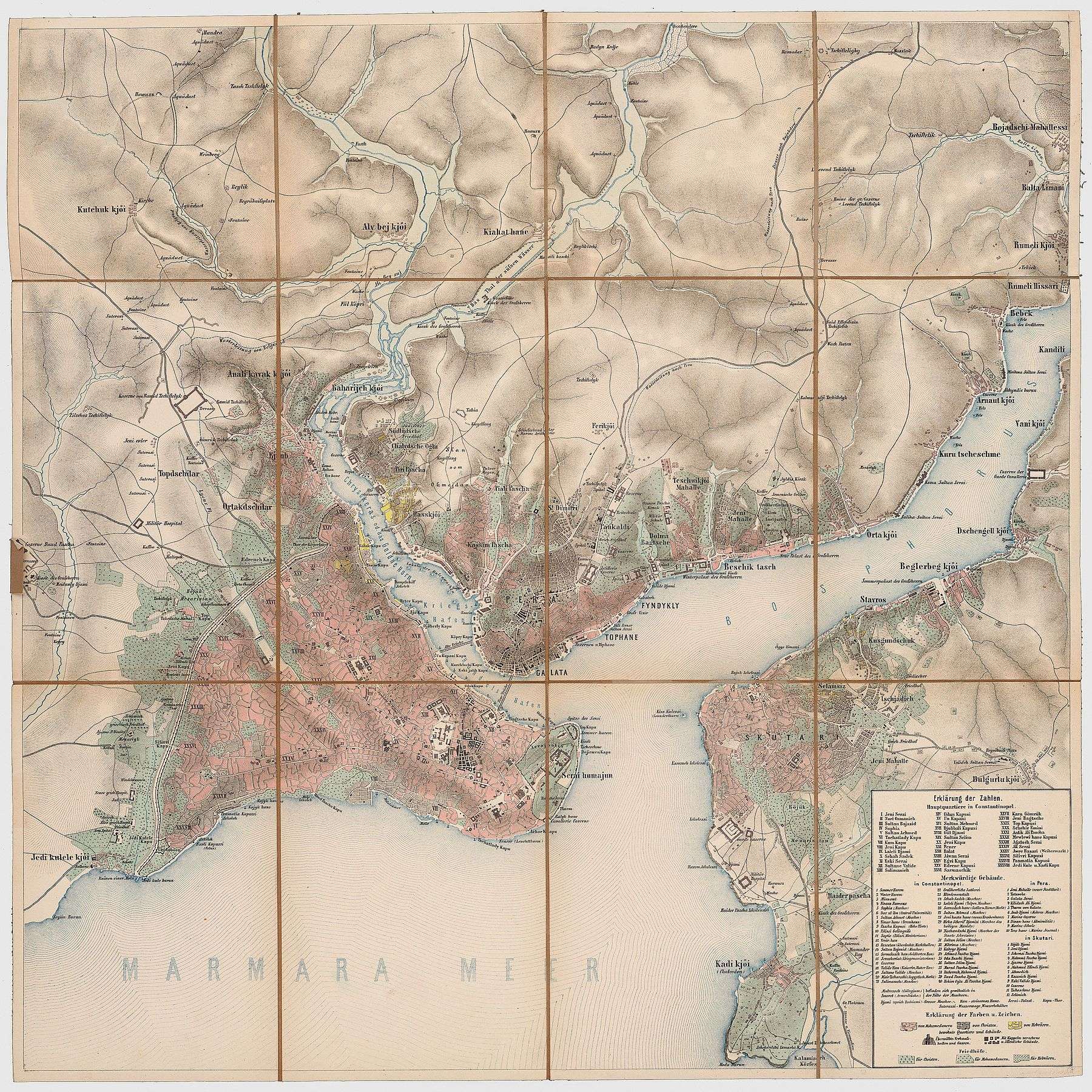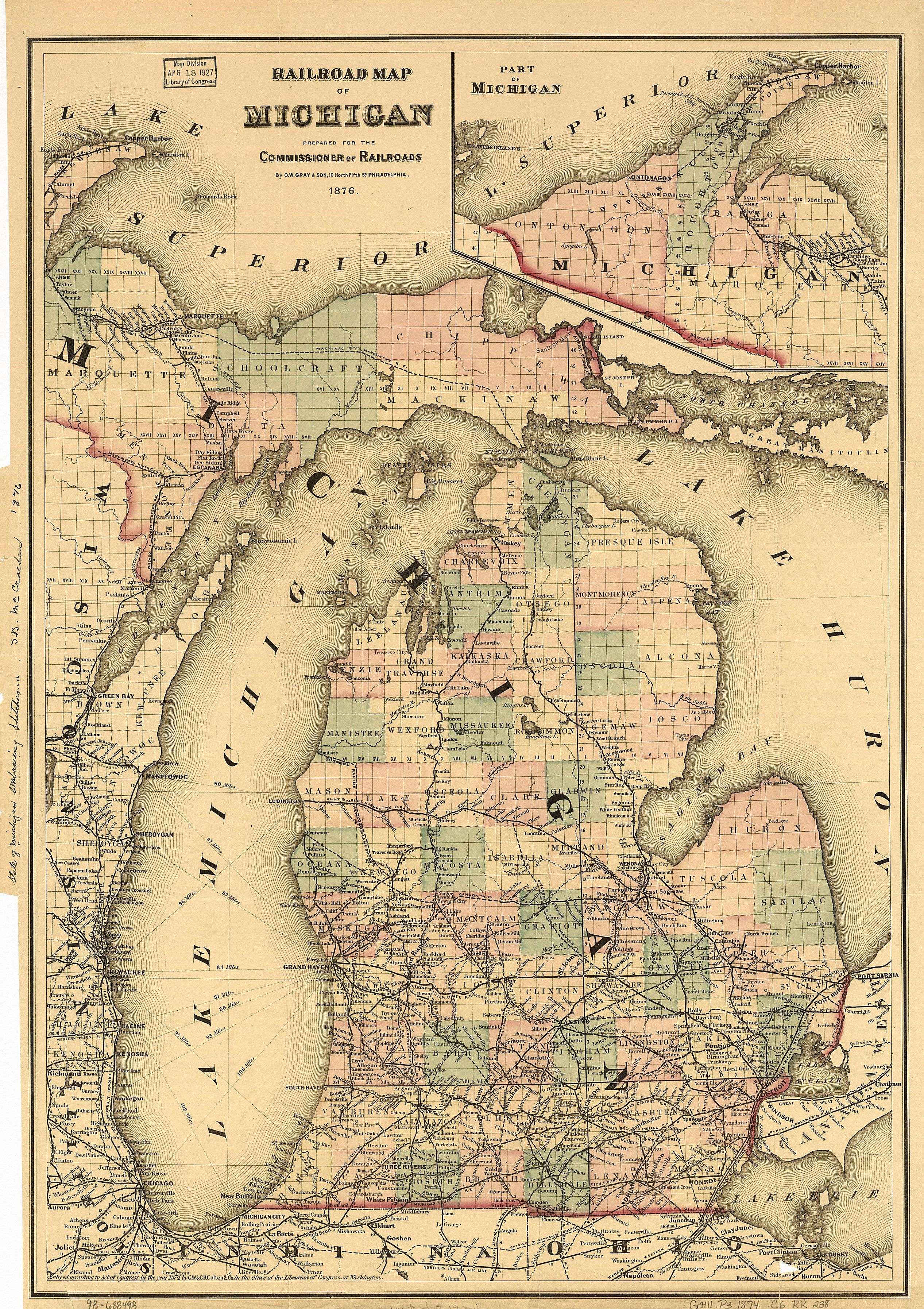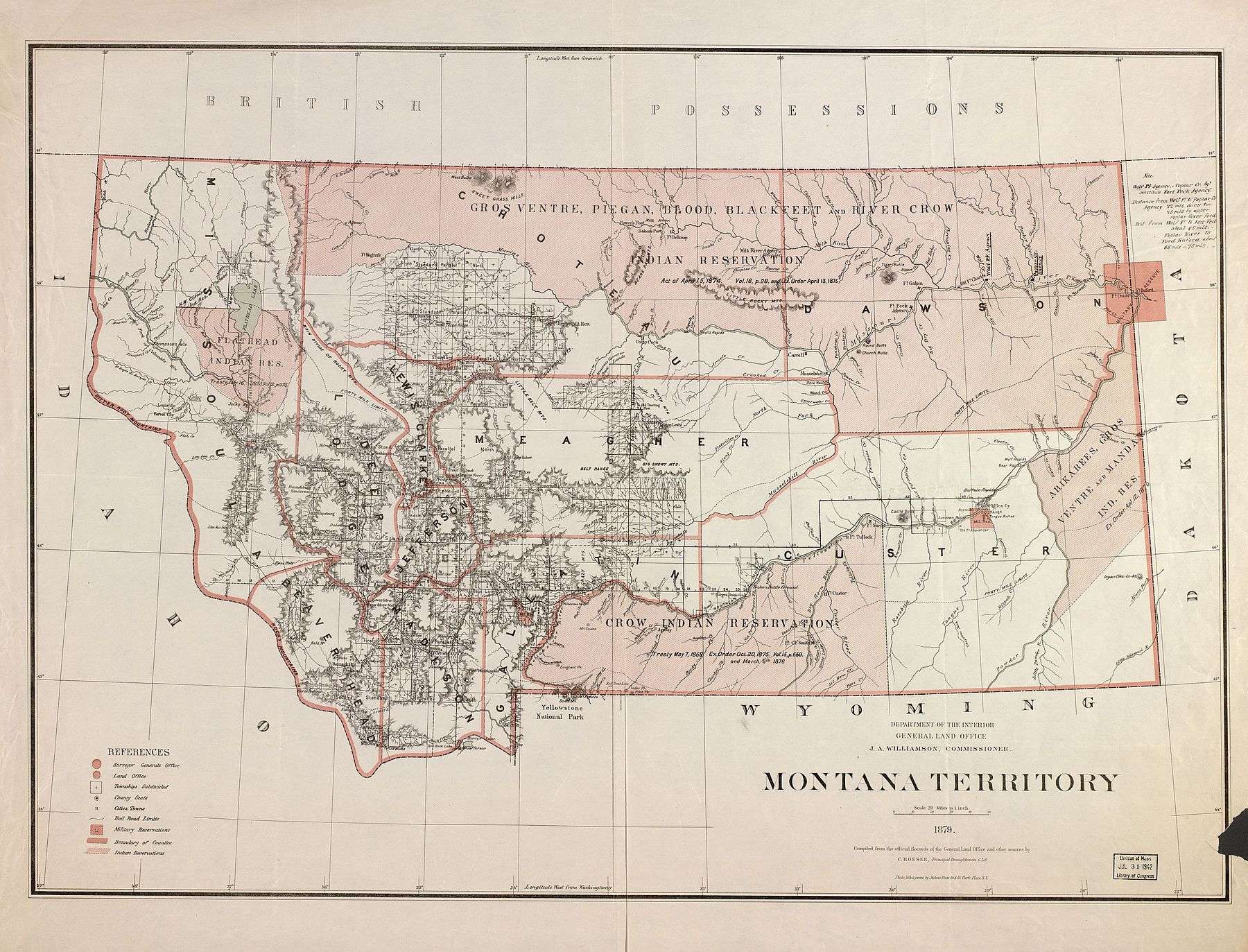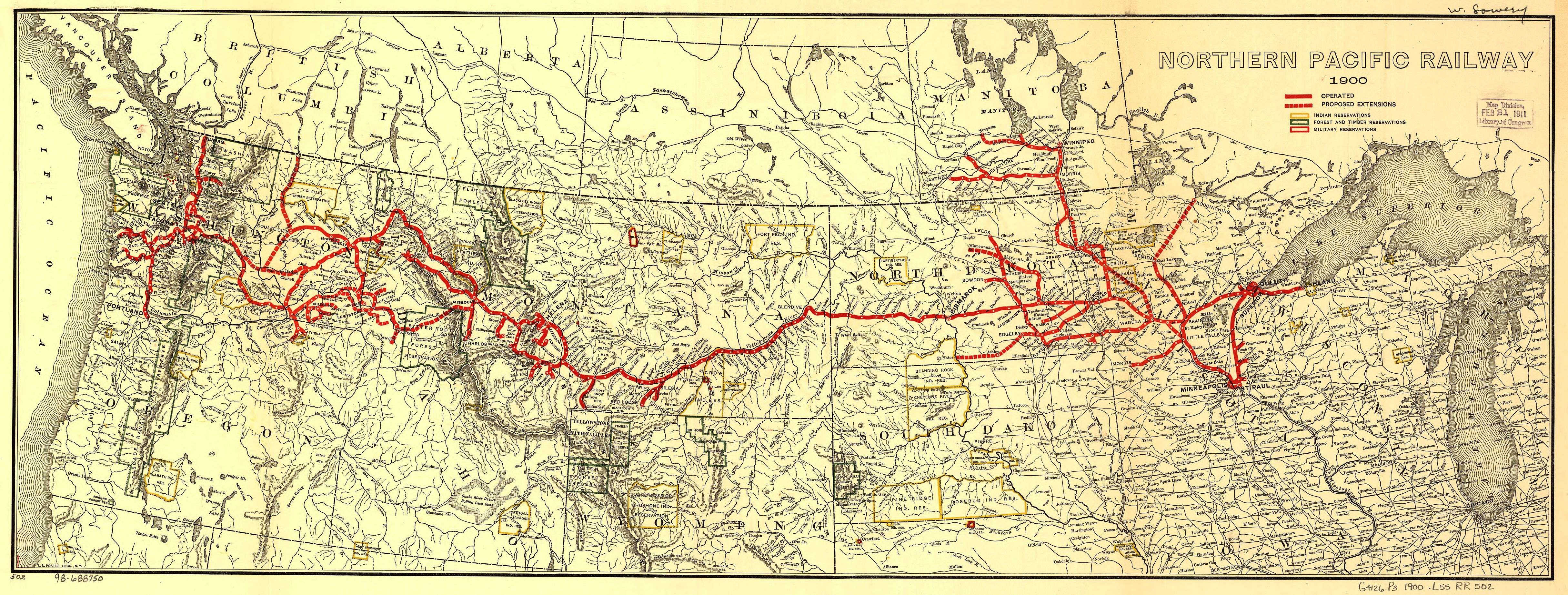George Warren Wood
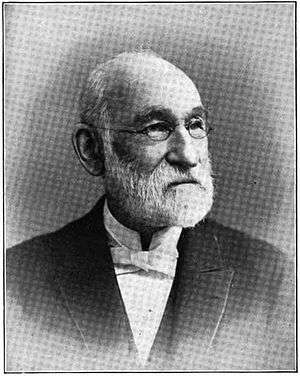
George Warren Wood (known professionally as George W. Wood) (1814-1901[1]) was a Presbyterian Minister and missionary who became the secretary of the Congregationalist American Board of Commissioners for Foreign Missions. He was an early missionary to Armenia under Cyrus Hamlin.
His son, also named George Warren Wood, was also a Presbyterian reverend and missionary. G. W. Wood Jr. (born in 1844 in Turkey, died January 21, 1924 in Fairhope, Alabama) served Presbyterian missions in Charlevoix, Michigan (1870s), the Montana Territory(1880s), and the Michilimackinaw area (1890s) before retiring to Alabama in 1901 to help start the Fairhope Single Tax Corporation.
Early life
Dr. Wood was born February 28, 1814 to Samuel and Mehitable (Peabody) Wood in Bradford, Massachusetts, near Haverhill, Massachusetts. Wood attended Bradford Academy and then graduated from Dartmouth College in 1832.[2] After teaching in a religious school in Elizabeth, NJ for four years and studying theology, Dr. Wood entered Princeton Theological Seminary for 6 months before being licensed and ordained as an evangelist by the Presbytery of Elizabethtown.
Career in missions
Mission work in Constantinople and elsewhere
He was ordained a Presbyterian missionary, at Morristown, N.J., on May 20, 1837.[3] With his wife Martha, he served in Singapore East India (May 1838 - June 1840);[4] Smyrna (1842), Trebizond Eyalet in the Ottoman Empire (1842-1843),[5] eight years at Constantinople(March 1842 - July 1850),[6] and associated with the Rev. Cyrus Hamlin in the Bebek Seminary.[7][8] He became in charge of Bebek's Theological department, the first of its kind in Asia Minor[9][10]
Return to the United States and work for the American Board
In 1850 he returned to the United States.[11] In September [12] 1852 he was elected Corresponding Secretary of the American Board of Foreign Missions in New York City,[13] and continued in this position until 1871.[14]
In Spring 1855, the ABCFM sent Dr. Wood to visit Choctaw Mission in Oklahoma to resolve a crisis over the abolition issue.[15] After arriving in Stockbridge Mission, Wood spent over two weeks days visiting missions including the Goodwater Mission, Wheelock Academy, Spencer Academy, and other mission schools. He met with missionaries to discuss Selah B Treat's June 22, 1848 letter permitting them to maintain fellowship with slaveholders.[16] Ultimately, the crisis was not resolved, and by 1859, the Board cut ties to the Choctaw mission altogether.
In 1856, Dr. Wood published a "Manual of Christian Theology" in Constantinople in association with Dr. H. G. O. Dwight and Rev. Dr. Edward Riggs.[17]
In addition to his other secretarial duties, Wood assisted in presiding over the historic closure and relocation of the original Broadway Tabernacle in New York City in 1857.
In December 1862, Dr. Wood sailed from New York on his way to assist the Western Turkey Mission with his skills in the Armenian language.[18] He stopped in London for several weeks to meet with the Turkish Missions Aid Society and arrived in Constantinople on March 7, 1863. During this time he also visited the Syria Mission. He returned to the United States June 6, 1864.[19]
Return to missions in Turkey
When the New School Presbyterians withdrew from the American Board, Dr. Wood resumed his missions work in Constantinople for another 16 years from 1871 to 1886.[20] While in Constantinople in 1879, Wood reported Turkish authorities in Amasia brutally persecuting Christian Armenian refugees from Soukoum Kaleh during the Russo-Turkish War (1877–78). He was able to coordinate with British Diplomat Edward Malet to bring the matter to the attention of the Sublime Porte, and then to the British foreign secretary Robert Gascoyne-Cecil (the Marquess of Salisbury).[21]
Personal life
Marriages
Dr. Wood had four wives over the course of his life.
- Dr. Wood married Martha Maria Johnson (Daughter of Silas & Mary Johnson) on April 24, 1838, and she died in childbirth 9 March 1839.[22]
- He married again Martha Briggs (Daughter of William Briggs of Boston) on December 29, 1841 in Philadelphia, PA. Mary bore four children (Sarah Johnson 1842, George Warren 1844, Louisa Whitehead 1846, and Henry Magie(sp?) 1849) in Turkey before she returned to the USA 1850-1851 on account of health, and died May 13, 1852.[23]
- He married a third time, to Mary C Hastings (daughter of Thomas Hastings[24] of New York City, and widow of Daniel Bond[25] ) on January 18, 1855.[26] Mary died March 4, 1862.
- In 1869, Wood married a fourth time, to Mrs. Sara Ann (McNair) Heylmun, who died August 17, 1901.
Death
Dr. Wood and his 4th wife (S.A. H. Wood) both died in 1901 and are buried together in the Mount Morris City Cemetery in Livingston County, New York.[27][28]
Children
Dr. Wood was survived by one son and one daughter.[29]
George Warren Wood, Junior
Dr. G.W. Wood's son, also named George Warren Wood, was also a Presbyterian reverend and missionary.
Early life
G. W. Wood Jr. was born in 1844[30] in Turkey [31] as his father was a missionary there. After graduating from Hamilton College in Upstate New York in 1865,[32] he taught and pursued advanced studies at the college of the City of New York.[33] He graduated from Union Theological Seminary in New York City in 1869.[34]
Early missionary career in Michigan
Rev. Wood, Jr became ordained as a Presbyterian pastor in the Saginaw Presbytery[35] and domestic missionary for the Presbyterian Board of Home Missions in Au Sable and Oscoda in January 1872.[36] He married Harriet Snyder in May 1872 in Iosco County[37] and then arrived in Charlevoix, Michigan in late November 1872.[38] to be appointed a Home Missionary in that place in 1873.[39][40] Wood, Jr. ministered in Charlevoix, Michigan and Bear River, Michigan from January 1874[41] to 1879.[42][43] During 1877-1879, he worked as a colporteur in the same region (reaching mainly homesteaders throughout Emmet County and Charlevoix County)[44] for the American Bible Society rather than for the Presbyterian Board of Home Missions.[45] Wood, Jr. had been a lifetime member of the ABS since at least 1873.[46]
Missionary work in Dakotas and Montana
He was a missionary at the Dakota Mission (Fort Peck/Wolf Point)[48][49] from 1879[50]-1889.[51][52] The first Presbyterian presence on the Fort Peck Indian Reservation began when Wood worked with the Native American (primarily Assiniboine and Sioux) population in 1881 and established a mission day school for children in 1883 on the north bank of the Missouri River, about three-quarters of a mile from present-day Wolf Point.[53] During this period, the natives grappled with the establishment of Camp Poplar River by the 11th Infantry, construction of the Montana Central Railway (later known as the Great Northern Railway), arrival of white settlers, US bans on the Sun Dance and other cultural practices, extinction of the Buffalo in northeast Montana, starvation during extremely harsh winters, and ultimately an agreement with the US government to re-drawing the boundaries of the Fort Peck reservation in exchange for federal subsidies.[54] The Presbyterian community he started there became "Union Church" in 1914 and celebrated its centennial in 2014 as "First Presbyterian Church" in Wolf Point.
Later missionary career in Northern Michigan
In 1892, Wood, Jr. was in Boyne, Michigan publishing a newspaper called "The Ensign"[55] From 1892 to 1893 Wood, Jr. was a home missionary in Lakefield, Michigan in the upper peninsula of Michigan.[56] Starting in 1892,[57] Wood was the editor and publisher of a weekly newspaper at Mackinaw City called the "Mackinaw Witness.
In 1894, Wood hosted Alabama native and missionary, Dr. George A. Weaver, as a fundraiser for the American Sunday School Union in the Mackinaw area.[58]
In 1894 Wood's Witness was listed as the sole newspaper published in Mackinaw City,[59] and continued to be published by him in 1897. "[60] In October 1897, the Cheboygan Democrat profiled the struggling Mackinaw Witness news operation and remarked that Rev Wood and his son George H. Wood were editor and manager respectively. The review noted that the Witness contained much "curious information" including railroad timetables, [lost] "cats and dogs", minor news, Sabbath Readings, New Earth columns, and "snide advertising" for questionable gold mining companies, single tax theory, crank books, and the Scientific American.[61] In November 1897, Wood wrote a letter in the Witness regarding his new colony on Mobile Bay in Alabama called the Fairhope Industrial Association.[62]
Progressive Era Politics and Retirement in Alabama

During the Progressive Era, Wood, Jr. moved to Fairhope, Alabama around 1900[63] (as early as 1897[64] or 1898[65]). His daughter Sarah Louise Wood married Fairhope pioneer[66] Clement LeFavre Coleman in 1902,[67] and in 1903, George Wood became a charter member [68] of the Fairhope Single Tax Corporation. He was Secretary of the FSTC in 1905,[69] and was its treasurer from 1908 to at least 1912.[70] In 1912, Wood, Jr.'s biography was listed in Herringshaw's American blue book of biography. As part of the FSTC, Wood became a member of the Fairhope Wharf Company in December 1912[71] and became president of the wharf company in January 1913.[72] Wood, Jr. lived in Fairhope as late as 1919, where he complained to the National Voters' League about extortion by the railway companies.[73] His wife Harriet Snyder Wood, after bearing Wood, Jr. two sons and five daughters,[74] died in Mount Pleasant, Washington, D.C. in 1922.[75] George Warren Wood Jr. died in 1924.[76]
References
- ↑ Greene, Joseph K. (1916). Leavening the Levant. Boston New York Chicago: Pilgrim Press / Rowland & Ives, New York. p. 89. Retrieved 14 April 2016.
- ↑ Robinson, C.S. (1891). Necrological reports and annual proceedings of the Alumni Association Volume 3: 1875-1932 (Volume 3: 1875-1932 ed.). Princeton, N.J: Princeton Theological Seminary. pp. 134–135. Retrieved 8 July 2016.
- ↑ Chapman, George Thomas (1867). Sketches of the Alumni of Dartmouth College. Cambridge: Riverside PRess. p. 265. Retrieved 11 April 2016.
- ↑ Robinson, C.S. (1891). Necrological reports and annual proceedings of the Alumni Association Volume 3: 1875-1932 (Volume 3: 1875-1932 ed.). Princeton, N.J: Princeton Theological Seminary. pp. 134–135. Retrieved 8 July 2016.
- ↑ Rev. M. P. Parmalee (1892). Proceedings of the ABCFM for the year 1892. Boston: Samuel Usher. p. 229. Retrieved 1 May 2017.
Trebizond was occupied as a missionary station in 1853... The following is a list of missionaries who have been connected with the station for at least one year: ... Rev. G. W. Wood, 1842 - 1843"
- ↑ Robinson, C.S. (1891). Necrological reports and annual proceedings of the Alumni Association Volume 3: 1875-1932 (Volume 3: 1875-1932 ed.). Princeton, N.J: Princeton Theological Seminary. pp. 134–135. Retrieved 8 July 2016.
- ↑ Proceedings of the ABCFM for the year 1850 (The Missionary Herald at Home and Abroad, Volumes 46-47). Boston: T.R. Marvin. 1850. p. 6. Retrieved 11 April 2016.
- ↑ Chapman, George Thomas (1867). Sketches of the Alumni of Dartmouth College. Cambridge: Riverside Press. p. 265. Retrieved 11 April 2016.
- ↑ https://books.google.com/books?id=FT99CAAAQBAJ&lpg=PA25&ots=KyHVGaFxH4&dq=George%20W.%20Wood%20Bebek%20Seminary&pg=PA25#v=onepage&q=George%20W.%20Wood%20Bebek%20Seminary&f=false
- ↑ Todd, Thomas (1901). The Missionary Herald, Volume 97. Boston: Beacon Press (American Board of Commissioners for Foreign Missions (ABCFM)). pp. 357–360.
- ↑ "Personnel records for George W. Wood". Digital Library for International Research -- American Board Personnel Card and Photo Collection. American Research Institute in Turkey-Istanbul / Amerikan Bord Heyeti (American Board), Istanbul. Retrieved 24 August 2016.
Ret. USA 1850-1852
- ↑ Robinson, C.S. (1891). Necrological reports and annual proceedings of the Alumni Association Volume 3: 1875-1932 (Volume 3: 1875-1932 ed.). Princeton, N.J: Princeton Theological Seminary. pp. 134–135. Retrieved 8 July 2016.
- ↑ "Personnel records for George W. Wood". Digital Library for International Research -- American Board Personnel Card and Photo Collection. American Research Institute in Turkey-Istanbul / Amerikan Bord Heyeti (American Board), Istanbul. Retrieved 24 August 2016.
Elected Sept 1852 Corresp. Sec'y Board, for N.Y. City
- ↑ Chapman, George Thomas (1867). Sketches of the Alumni of Dartmouth College. Cambridge: Riverside PRess. p. 265. Retrieved 11 April 2016.
- ↑ Spring, Joel (1996). Books on Google Play The Cultural Transformation of A Native American Family and Its Tribe 1763-1995: A Basket of Apples. New York, London: Routledge (Taylor & Francis Group). ISBN 0-8058-2303-4.
in 1855, the American Board decided to send George Wood to investigate the situation in Indian Misisons... While visiting the Choctaw Nation, Wood spent 3 days each at the Wheelock and Spencer Academies, and 9 days at other schools
- ↑ Cassity, Michael; Goble, Danney (2009). Divided Hearts: The Presbyterian Journey Through Oklahoma History. Norman: University of Oklahoma Press. pp. 77–80. ISBN 978-0-8061-3848-0. Retrieved 24 August 2016.
members of the mission met Wood at Goodwater Mission, a school that had been suspended since 1853 ... Part of the key [to cordial discussion] was Wood's decision at the outset to 'drop for the present' the contentious letter from the American Board of June 22, 1848
- ↑ Ceowell, E. P. OBITUARY RECORD of Graduates of Amherst College for the Academical Year ending June 28, 1893 (Fourth Printed Series, No. 1. ed.). Amherst College. p. 293. Retrieved 5 January 2017.
It has been found impossible to obtain a complete list of the works composed, edited or translated by Dr. Riggs. His principal publications are as follows :"... "Manual of Christian Theology, in association with Dr. H. G. O. Dwight and Dr. G. W. Wood. Constantinople, 1856.
- ↑ Annual Report of the American Board of Commissioners for Foreign Missions (1863). 42 Congress Street, Boston: T.R. Marvin & Son. 1863. p. 36. Retrieved 24 August 2016.
"As Dr. Wood was previously located there, and still retained his knowledge of Armenian, ... he sailed from New York ... December 6, 1862 ... Turkish Missions Aid Society detained him in England, a few weeks... did not reach his destination till the 7th of March
- ↑ "Personnel records for George W. Wood". Digital Library for International Research -- American Board Personnel Card and Photo Collection. Amerikan Bord Heyeti (American Board), Istanbul.
Returned to Cons'ple Mar 7, 1863, as Secy, &visited [illegible] & Syria Mission... ret to USA June 6, 1864
- ↑ The Missionary Herald at Home and Abroad, Volume 97. Boston: Beacon Press. September 1901. pp. 357–360. Retrieved 13 April 2016.
On account of the withdrawal of the New School Presbyterian body from the support of the American Board"... "In the second period of his missionary life at Constantinople (1871 - 1886)
- ↑ Parliamentary Papers, House of Commons and Command, Volume 80. Constantinople: Great Britain. Parliament. House of Commons. 1880. pp. 70–72. Retrieved 3 January 2017.
- ↑ http://www.pcmorristown.org/about-us/graveyard/alphabetical-index-of-interments/w-alpha-grave-yard
- ↑ "Personnel records for Martha Briggs Wood". Digital Library for International Research - American Board Personnel Card and Photo Collection. American Research Institute in Turkey-Istanbul. Retrieved 24 August 2016.
- ↑ Williams, Hermine Weigel (2005). Thomas Hastings: An Introduction to His Life and Music (e-book ed.). New York Lincoln Shanghai: iUniverse, Inc. p. 50. ISBN 978-0-595-81089-5. Retrieved 13 April 2016.
footnote #6: Their daughter Mary was married first to Rev Daniel Bond... then to the Rev. George W. Wood
- ↑ General Catalogue of the Auburn Theological Seminary. Auburn, NY: Daily Advertiser and Weekly Journal Printing House. 1883. p. 208. Retrieved 13 April 2016.
- ↑ Chapman, George Thomas (1867). Sketches of the Alumni of Dartmouth College:. Cambridge: Riverside PRess. Retrieved 13 April 2016.
- ↑ "George W. Wood". Find a Grave. Retrieved 22 August 2016.
"George W. Wood, Minister, Missionary" on the gravestone
- ↑ "Sarah A. Wood". Find a Grave. Retrieved 22 August 2016.
"S.A.H. Wood, Wife of Rev. G.W. Wood" on the gravestone
- ↑ Robinson, C.S. (1891). Necrological reports and annual proceedings of the Alumni Association Volume 3: 1875-1932 (Volume 3: 1875-1932 ed.). Princeton, N.J: Princeton Theological Seminary. pp. 134–135. Retrieved 8 July 2016.
- ↑ Distinguished Successful Americans of Our Day: Containing Biographies of Prominent Americans Now Living. Chicago, IL: Successful Americans. 1912. p. 453.
- ↑ http://charlevoix.migenweb.net/births/birth033.htm
- ↑ Bates, William H.; Betts, Truman; Hall, George W. "The Hamiltonian (1886)" (PDF). hamilton.edu. Hamilton College. Retrieved 14 March 2017.
- ↑ Tompkins, Hamilton Bullock (1877). Biographical Record of the Class of 1865, of Hamilton College. p. 77. Retrieved 11 April 2016.
- ↑ Distinguished Successful Americans of Our Day: Containing Biographies of Prominent Americans Now Living. Chicago, IL: Successful Americans. 1912. p. 453.
graduated from Union Theological seminary in 1869
- ↑ Minutes of the Synod of Michigan. Detroit: Tribune Book and Job Office. 1883. pp. 42–43. Retrieved 4 May 2016.
The Sagniaw Presbytery reports... Geo. W. Wood has received ordination
- ↑ The Presbyterian Monthly Record of the PCUSA Volume 22. Philadelphia: Presbyterian Board of Publication. 1871. p. 70. Retrieved 4 May 2016.
- ↑ Dibean, Jack; Dibean, Marianne. "Iosco County, Michigan Dibean Marriage Index". files.usgwarchives.net. Retrieved 10 May 2016.
- ↑ "Rosa Nettleton excerpts from the Charlevoix Sentinel for the year 1872". Charlevoix Public Library. Retrieved 4 May 2016.
The Presbyterian Society of this place have secured the clerical services of Rev. Geo. W. Wood, late of Au Sable, who arrived lately with his family and household effects. He will preach at the school house at 7 P.M.
- ↑ The Presbyterian Monthly Record of the Presbyterian Church in the United States of America: Being the Organ of the Boards of Home Missions, Education, Foreign Missions, Publication, Church Erection, Relief for Disables Ministers, Missions for Freedmen, and Aid for Colleges and Academies, Volume 24. Philadelphia: Presbyterian Board of Publication. 1873. p. 78.
Home Mission Appointments made in January 1873...Rev. Geo. W. Wood, Charlevoix ch., Mich.
- ↑ Nettleton, Rosa. "Highlights of Charlevoix History 1869 to 1906 from the Charlevoix Sentinel". charlevoixlibrary.org. Retrieved 14 April 2016.
The work of the Presbyterian Board of Home Missions in this field twenty or more years ago, should not be confounded with the origin of the present Congregational Society. Back almost as far as local history reaches, the Presbyterians had a mission here. The pastor in charge of the work was Rev. George W. Wood. He labored here about six years, when, for some cause unknown to the writer that denomination abandoned the work here; but, unquestionably from that early Christian movement sprang the present prosperous Congregational Church of Charlevoix.
- ↑ Presbyterian Monthly Record of the PCUSA Vol 25. Philadelphia: Presbyterian Board of Publication. 1874. p. 70.
- ↑ Minutes of the General Assembly of the PCUSA - United Presbyterian Church in the U.S.A., Volume 5, Part 2. New York: Presbyterian Board of Publication. 1879. p. 888. Retrieved 14 April 2016.
- ↑ Tompkins, Hamilton Bullock (1877). Biographical Record of the Class of 1865, of Hamilton College. p. 77. Retrieved 11 April 2016.
- ↑ Sixtieth Annual Report of the American Bible Society. New York: American Bible Society. 1876. p. 59. Retrieved 12 July 2016.
Charlevoix and Emmet Counties... have been throughly explored by Rev. G.W. Wood, who was employed as a colporteur by the American Bible Society... The people are extremely impecunious at present, being mainly homesteaders...the colporteur has gone on foot... [with] his Bible laden knapsack, in paths where no vehicle could go, and by boats on the lakes and rivers
- ↑ Distinguished Successful Americans of Our Day: Containing Biographies of Prominent Americans Now Living. Chicago, IL: Successful Americans. 1912. p. 453.
He was under the American bible society in 1877, 78 and 79
- ↑ Annual Report of the American Bible Society. New York: American Bible Society. 1872. p. 175. Retrieved 24 October 2017.
Appendix containing ... a list of... the life ... members of the society p175: "Wood, George Warren, Jr., New York."
- ↑ Shanley, James; Smith, Dennis; McGeshick, Joseph R.; Miller, David Reed (2008). The History of the Assiniboine and Sioux Tribes of the Fort Peck Indian Reservation, Montana, 1800 - 2000. Poplar, MT: Fort Peck Community College. p. 497. Retrieved 21 February 2017.
- ↑ Crawford, Suzanne; Kelley, Dennis (2005). American Indian Religious Traditions, An Encyclopedia: A-I. Santa Barbara, California / Denver, Colorado / Oxford, England: ABC-CLIO. p. 536. ISBN 1-57607-517-6. Retrieved 13 April 2016.
In 1880 George W. Wood established a Presbyterian mission at Fort Peck
- ↑ The Church at Home and Abroad, Volume 2. Philadelphia, PA: Presbyterian Board of Publication and Sabbath-School Work (General Assembly of the PCUSA). 1887. p. 71.
Wolf Point, Montana Territory: On the Missouri river... 1883; missionaries, Rev. George W. Wood Jr., and his wife.
- ↑ Herringshaw, Thomas William (1914). The American Blue Herringshaw's American Book of Biography: Prominent Americans of 1914. Chicago, Illinois: American Publishers' association. p. 1005. Retrieved 10 May 2016.
- ↑ Distinguished Successful Americans of Our Day: Containing Biographies of Prominent Americans Now Living. Chicago, IL: Successful Americans. 1912. p. 453.
- ↑ The Foreign Missionary (containing particular accounts of the work of the Board of Foreign Missions of the Presbyterian Church and selected articles and facts from the missionary publications of other protestant societies) Volume 44. New York: Mission House (Presbyterian Church in the U.S.A. Board of Foreign Missions). 1885–1886. p. 59.
- ↑ Plestina, John (November 2014). "First Presbyterian Church Celebrates Centennial In November". northeastmontananews . com. The Herald News. Retrieved 21 February 2017.
The 133-year Presbyterian history on the Fort Peck Indian Reservation began with Rev. George Wood working with the Native American population in 1881 and establishing a mission day school for children in 1883 on the north bank of the Missouri River, about three-quarters of a mile from present-day Wolf Point.
- ↑ Shanley, James; Smith, Dennis; McGeshick, Joseph R.; Miller, David Reed (2008). The History of the Assiniboine and Sioux Tribes of the Fort Peck Indian Reservation, Montana, 1800 - 2000. Poplar, MT: Fort Peck Community College. p. 497. Retrieved 21 February 2017.
- ↑ "About The ensign. (Boyne, Mich.) 1892-1???". Chronicling America. Library of Congress.
Title:The ensign... Publisher:George Warren Wood...Frequency:Monthly
- ↑ Distinguished Successful Americans of Our Day: Containing Biographies of Prominent Americans Now Living. Chicago, IL: Successful Americans. 1912. p. 453.
- ↑ Rowell, George (1893). Rowell's American Newspaper Directory. New York: Geo P. Rowell & Company. p. 377. Retrieved 31 May 2016.
Mackinaw City, Cheboygan County"... "WITNESS: Saturdays; four pages 16x22; subscription $1.50; established 1892; Rev. G. W. Wood, editor and publisher.
- ↑ "Country Cousins: all the nest from Granherdom gathered for the Democrat" (19). Forsyth & Bunnell. Cheboygan Democrat. 7 July 1894. p. 5. Retrieved 4 January 2017.
The missionary, George A. Weaver, made an address, and a collection was taken for the American Sunday School Union, amounting to $3 The school has grown in about a year from fifteen to more than eighty members. He pronounces it a model school Mr. Weaver and his family were guests of P. 0, Munroe, the veteran settler after whom the t iwnskip is named, ns well as Rev. G. W. Wood of Mackinaw City.
- ↑ Donaldson, W. H. (1894). The Donaldson, Guide: Containing a List of All Opera-houses in the United States and Canada. Cincinnati, OH: Donaldson. p. 167. Retrieved 31 May 2016.
Newspaper -- Witness, Rev. G.w. Wood, editor
- ↑ Clark, C.F. (1897). Michigan State Gazetteer and Business Directory for 1897 (Volume 13). Detroit: R.L Polk & Co. p. 1138. Retrieved 10 May 2016.
"[Mackinaw] has a weekly newspaper, The Mackinaw Witness" ... "George H. Wood, publr... Wood, Rev George W (Presbyterian)
- ↑ Forsyth, Edward (16 October 1897). "We And Our Neighbors" (18th Year No. 30). Forsyth & Bunnell. Cheboygan Democrat. p. 4. Retrieved 4 January 2017.
One of the Democrat's Interesting exchanges Is the Mackinaw Witness, pub ■ fished at Mackinaw City, by Rev. G. W. Wood, editor, and Geo. H, Wood, manager....
- ↑ "Letter dated 1/8/1898 to Rev. G. W. Wood in Fairhope, Alabama from Charles S. Hampton in Petoskey, Michigan". http://fairhopesingletax.pastperfectonline.com. Retrieved 4 January 2017.
I was considerably interested in a letter which you wrote The Witness and which was published in the issue of No13th, concerning the Fairhope Industrial Assn." ... "a .. colony on the east shore of Mobile Bay, where I understand your colony is located
External link in|website=(help) - ↑ "George W. Wood papers (ID#02878)". Detroit Public Library. Burton Historical Collection. Retrieved 14 April 2016.
Biographical/Historical note:Born in Constantinople to missionary parents, George W. Wood became a Presbyterian minister and missionary to the Native Americans in Michigan, the Dakotas and Minnesota. He lived in Fairhope, Alabama about 1900 and was treasurer of the Fairhope Single Tax Corporation. George W. Wood died on Jan. 21, 1924.
- ↑ Wood, George Warren (1905). The Country Gentleman (Volume 70 (June 8, 1905) ed.). Albany, New York: Luther Tucker & Son. p. 535. Retrieved 19 April 2017.
"this (Baldwin) county [is] 'nature's great sanitarium.' I was here during the epidemic of yellow fever in 1897" - G. W. Wood, talking about Fairhope's healthful climate
- ↑ "Letter dated 1/21/1898 to Rev. G. W. Wood in Fairhope, Alabama from Charles S. Hampton in Petoskey, Michigan". http://fairhopesingletax.pastperfectonline.com. Retrieved 4 January 2017.
Letter dated 1/21/1898 to Rev. G. W. Wood in Fairhope, Alabama
External link in|website=(help) - ↑ "Land and freedom". New York City :. Single Tax Pub. Co. June–July 1943. pp. 190–110. Retrieved 19 April 2017.
CLEMENT L. COLEMAN is dead at the age of eighty. He was one of Fairhope's pioneers and served for two years as member of the Fair- hope Town Council. He is survived by his wife and two children, Genevieve and Henry George Coleman. He was long a subscriber to LAND AND FREEDOM.
- ↑ Watrous, Jerome A., ed. (1909). Memoirs of Milwaikee County (Volume II ed.). Madison, WI: Western Historical Association. p. 161. Retrieved 19 April 2017.
...Fairhope Ala., in which latter place he [Clement LeFevre Coleman] has made his home for the last fourteen years. He married on Sep 30, 1902 Sara L., daughter of Rev. George W. Wood of Petoskey, Mich. Their children are Henry George coleman (1903)... and Genevieve Coleman (1906)
- ↑ Huntington, Charles White (1922). Enclaves of Single Tax or Economic Rent: Being a Compendium of the Legal Documents Involved together with a historical description. Boston: Warren Fiske / Merrymount Press. p. 23. Retrieved 14 April 2016.
- ↑ "Membership Certificate # 70 in the Fairhope Single Tax Corporation (on the old Fairhope Industrial Association form) issued to William A. Baldwin on 3/7/1905". http://fairhopesingletax.pastperfectonline.com. Retrieved 4 January 2017. External link in
|website=(help) - ↑ Distinguished Successful Americans of Our Day: Containing Biographies of Prominent Americans Now Living. Chicago, IL: Successful Americans. 1912. p. 453.
- ↑ "Meeting Minutes of the Wharf Company dated 12/16/1912". http://fairhopesingletax.pastperfectonline.com. Retrieved 4 January 2017.
G. W. Wood replaces the deceased J. M. Beckner.
External link in|website=(help) - ↑ "Meeting Minutes of the Wharf Company dated 1/30/1913 in which G.. W. Wood is elected president". http://fairhopesingletax.pastperfectonline.com. Retrieved 4 January 2017. External link in
|website=(help) - ↑ Wood, G.W. (1919). Haines, Lynn, ed. The Searchlight on Congress, and on the Democracy which Gives it Existence, Volumes 4-5 (The Searchlight newsletter) (Volume IV, Number 4 (August 1919) page 29 ed.). United States. p. 29. Retrieved https://books.google.com/books?id=iCo4AQAAMAAJ&lpg=RA3-PA29&ots=Oebf_Knoj5&dq=%22Mackinaw%20Witness%22&pg=RA3-PA29#v=onepage&q=%22Mackinaw%20Witness%22&f=false.
1 column editorial entitled "Where Blanton Blundered","Fairhope, Ala, 11 July 1919.", signed by "G.W. Wood"
Check date values in:|accessdate=(help) - ↑ Distinguished Successful Americans of Our Day: Containing Biographies of Prominent Americans Now Living. Minnesota / Chicago IL: Successful Americans. 1912. p. 453. Retrieved 8 July 2016.
- ↑ "DEATHS". The Washington herald. July 6, 1922. p. 2. Retrieved 4 January 2017.
"Harriet Snyder Wood, 77, The Earlington" (The Earlington is now called Claiborne Apartments at 3033 16th St)
- ↑ "George W. Wood papers (ID#02878)". Detroit Public Library. Burton Historical Collection. Retrieved 14 April 2016.
Biographical/Historical note:Born in Constantinople to missionary parents, George W. Wood became a Presbyterian minister and missionary to the Native Americans in Michigan, the Dakotas and Minnesota. He lived in Fairhope, Alabama about 1900 and was treasurer of the Fairhope Single Tax Corporation. George W. Wood died on Jan. 21, 1924.
